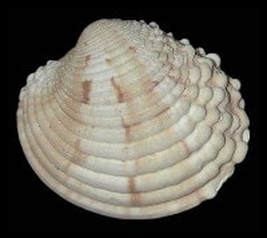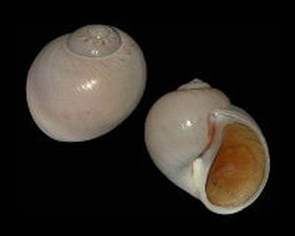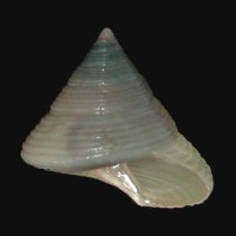Collecting in Carmarthenshire
by Jonathan Welsh
Photographs courtesy of Gonçalo Rosa / Atoll Specimen Shells
Photographs courtesy of Gonçalo Rosa / Atoll Specimen Shells
Anyway, for our holiday this year, Lynn and I headed to Wales. In May. The previous week's weather had been excellent but the forecast for the 18th to 25th was not so good. So we set off on a Saturday morning and arrived mid-afternoon in Laugharne, not far from St Clears. The weather at that time was fine, because it wasn't raining!
By the following morning, however, it was quite unpleasant with high winds and squally showers, hardly the sort of weather that you want to wander along a beach in. Before we had left, I had emailed Janice Light from the Conchological Society to ask her if there were any good places to visit and she had suggested a place called Burry Holms. However, due to my not being "compos mentis" I thought she'd said Burry Port. As it wasn't too far, we decided to go there, only realising when nearly there that it was Burry Holms she'd suggested and it was a lot further away. Anyway, we decided to press on and about an hour and a half later we arrived in a caravan park.
As usually happens at this point, I left Lynn in the car reading and headed out across the sand towards the headland about one and a half miles away. Employing my usual technique of wandering along the strand-line, after a short while I found a very large Natica catena, da Costa 1778, half-buried in the sand along with lots of Crepidula fornicata, Linné 1758. There were numerous bivalves also, including Mytilus edulis, Linné 1758, Ostrea edulis, Linné 1758, Cerastoderma edule, Linné 1758, Venerupis rhomboides, Pennant 1777, Venus verrucosa, Linné 1758, Tellina tenuis, da Costa 1778, loads of Ensis siliqua, Linné 1758, E. ensis, Linné 1758, Lutraria lutraria, Linné 1758, Mya arenaria, Linné 1758 and most of the other common bivalves from our shores. Being not specially interested in these, I left them alone.
In Janice's email, she'd said that I should be able to find Clathrus clathrus, Linné 1758 at this locality and as it is a shell which I don't have, I decided to try. However, all I did find on the beach was lots more Natica catena, loads of assorted bivalves and one Calliostoma zizyphinum, Linné 1758. Very disheartened, I set off back to the car. While striding along the high tide line in my trusty hiking boots, I accidentally crushed a Sea Urchin, specifically Echinocardium cordatum, Pennant 1777. Now really annoyed (I'd never even seen one before, except in a book), I stomped on, now and then looking down at the sand. Some time later, I just managed to avoid crushing another, slightly smaller E. cordatum, so I picked it up and stowed it very carefully away in my knapsack.
Later still, attempting to find my way back to the car through the dunes, I stumbled into a sand trap with numerous dead Cepaea nemoralis, Linné 1758 and Helix aspersa, Müller 1774. As I am also interested in terrestrial gastropods, I picked up two of these and put them away. Lastly, just as I was about to join the path to the car park, I found another sand trap and sitting in the middle of this, all on its own, was a perfect example of Acteon tornatilis, Linné 1758. I picked this up and returned to the car.
The next day we went anywhere to collect was the Wednesday. We drove along in reasonable weather to Pendine Sands, a little seaside resort. The most abundant mollusc on the beach here was again Natica catena but among the rocks at the base of the cliffs were hundreds and hundreds of bivalves, mostly smashed into fragments by the pounding of the waves. Lynn found a huge (over 120mm) Buccinum undatum, Linné 1758 wedged between the rocks. We tried to free it but sadly the tide and weather were closing in and so we had to leave it alone. So we gave up and headed back along the coast road, stopping off at Amroth for a brief look for anything different. Here, the beach has only a small area of sand, the rest is rocks and small pebbles and the shells seem to be only in this area. Here (aside from the obligatory bivalves) I found a single Monodonta lineata, da Costa 1778 and two very badly beached Nassarius reticulatus, Linné 1758. I left the Nassarius and then we headed home.
Overall, considering that this was supposed to be a classic locality, I was disappointed. However, I had never found any Natica, Acteon or Echinocardium in the UK before so from that point of view it was worth going. Shame about the lack of Clathrus! Maybe next year …!
This article by Jonathan Welsh was first published in our magazine Pallidula in October 2002.
We would like to thank Gonçalo Rosa of Atoll Specimen Shells for the use of his copyright photographs.
We would like to thank Gonçalo Rosa of Atoll Specimen Shells for the use of his copyright photographs.
|
Marine gastropods
Actaeon tornatilis, Linné 1758 Buccinum undatum, Linné 1758 Calliostoma zizyphinum, Linné 1767 Crepidula fornicata, Linné 1758 Monodonta lineata, da Costa 1778 Nassarius reticulatus, Linné 1758 Natica catena, da Costa 1778 Terrestrial gastropods Cepaea nemoralis, Linné 1758 Helix aspersa, Müller 1774 |
Bivalves (selected)
Cerastoderma edule, Linné 1758 Ensis ensis, Linné 1758 Ensis siliqua, Linné 1758 Lutraria lutraria, Linné 1758 Modiolus modiolus, Linné 1758 Mya arenaria, Linné 1758 Mytilus edulis, Linné 1758 Tellina tenuis, da Costa 1778 Venerupsis rhomboides, Pennant 1777 Venus verrucosa, Linné 1758 |
OTHER
Echinoids
Echinocardium cordatum, Pennant
Echinoids
Echinocardium cordatum, Pennant



